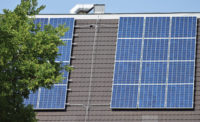Selling the Sustainability of Roof Underlayments

This month we shine the spotlight on one of the fastest-growing categories of roofing products: roof underlayments. For someone like me who’s worked in the roofing industry for many decades, it’s been amazing to witness how the lowly-saturated organic felt has evolved into so many high-performance underlayments that provide significant improvements to roof system sustainability.
Most of the new underlayments offer a flatter, more uniform work surface to improve the consistency of roof application, while at the same time resist the elements before and after installation. Many modern underlayments also improve the overall strength of the roofing system, especially in terms of wind resistance, while others offer breathability to transfer trapped moisture and redundancy to restist ice damage. And finally, the light weight and skid-resistance of many modern roof underlayments benefit roofing crews by making installation easier and safer.
Although modern roof underlayments can help enhance the sustainability of roofing systems, they don’t necessarily sell themselves. In fact, as a product hidden from view and frequently not on the mind of your customer, it usually requires an organized marketing and selling effort on your part to help your customers move up to the higher level of performance and sustainability.
I’m a firm believer that consumers benefit when they have an opportunity to select from products that offer different levels of performance and value. And few products lend themselves to the time-honored “good, better, best” election process as well as modern roof underlayments. As an example, you might start with a glass-reinforced organic product that provides a higher wind and tear resistance to help increase service life. Next, you might move to a synthetic underlayment that offers breathability in addition to increased wind and tear resistance. And finally, you might offer thicker self-adhering underlayments that provide a significant level of ice and water resistance in addition to high strength.
By offering a range of different underlayments, you provide your customer with the opportunity to not only opt for better, more sustainable roofing choices, but also to really think through exactly what they’re looking for in their next roof.
Provide samples
Although it’s important to clearly describe to your customer exactly what features and benefits each roof underlayment option offers, don’t rely solely on verbal or written information.
Make sure the samples you show actually help tell the story. If you want to explain how modern underlayments improve the flatness and uniformity of the completed roof, you may need to construct samples on pieces of plywood decking — including a sample of a wrinkled and torn organic felt to provide an effective contrast to the better-performing underlayments. Similarly, if the feature you want to demonstrate is strength and tear-resistance, make sure the samples are large enough for the customer to grab and pull on.
Integrate Warranty Offerings
Not only do most roof system manufacturers include underlayments in their warranty coverage, the type of underlayment may play a key role in determining warranty length. Even if your customer elects not to purchase an enhanced warranty, the specific products included at each warranty level may help the customer make the best decisions.
Looking for a reprint of this article?
From high-res PDFs to custom plaques, order your copy today!







